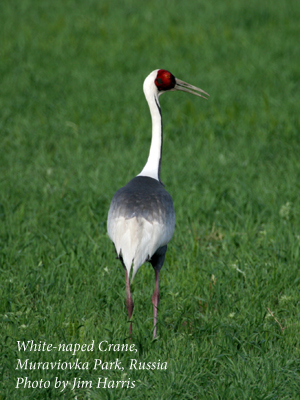 When Muraviovka Park began its activities in Far Eastern Russia in 1994, it was the first privately managed protected area in the country. The fact that it was a pioneer in sustainable land use then is paying big conservation dividends today!
When Muraviovka Park began its activities in Far Eastern Russia in 1994, it was the first privately managed protected area in the country. The fact that it was a pioneer in sustainable land use then is paying big conservation dividends today!
Since mid-August numbers of migratory cranes at Muraviovka Park have been growing. In early September at just two roosting sites we sighted over 1,900 cranes, predominantly Hooded Cranes. In October, around 1,500 cranes of five species (Hooded, White-naped, Eurasian, Red-crowned and Siberian) roosted near the park’s headquarters. Numbers of Siberian Cranes in Muraviovka Park during the fall migration have been growing during the last couple of years, and during one day in October we found 33 Siberian Cranes, including two families with chicks. We are especially encouraged by this number, since Siberian Cranes are among the world’s three most endangered crane species (Whooping and Red-crowned Cranes being the other two). Oddly, the Siberian Cranes are feeding in crop fields, keeping company with the other crane species (normally Siberian Cranes stay in wet places to forage). The crane concentrations at the park appear to be due to protection from disturbance and the increase in nearby areas planted with corn, as the cranes feed in the harvested fields.
Due to the dry fall of 2014 and spring-summer of 2015, in areas outside of Muraviovka Park, storks and cranes abandoned most of the nesting areas that they had occupied in 2013-2014. However, within or close beside the park, numbers of nesting cranes and storks remain surprisingly high, with 19 pairs each of White-naped Cranes and Oriental White Storks! As of early September, at least 10 White-naped Crane pairs had successfully raised chicks.
Three pairs of Red-crowned Cranes occupied nesting territories within the Park, with two of the pairs raising two chicks until late August (unfortunately, one of the pairs lost a chick after the opening of hunting season). A fourth family of Red-crowned cranes with two chicks was sighted in October, 3 km southeast of the Park. In addition, we have finally managed to identify a banded female Red-crowned Crane that has been successfully nesting and raising chicks at the same site for at least six consecutive years – and determined that this bird was banded at Khingansky Nature Reserve in 1993 by our Japanese colleague Dr. Ozaki!
Since there are very few such exceptional places in the world, Muraviovka Park and adjacent territories in the Amur River basin are included in the exclusive Ramsar List of Wetlands of International Importance. The growing crane numbers in the park are testament to the incredible power of habitat protection.
 Story submitted by Dr. Sergei Smirenski, Research Associate for the International Crane Foundation based in Russia. Click here to learn more about our work in East Asia.
Story submitted by Dr. Sergei Smirenski, Research Associate for the International Crane Foundation based in Russia. Click here to learn more about our work in East Asia.
